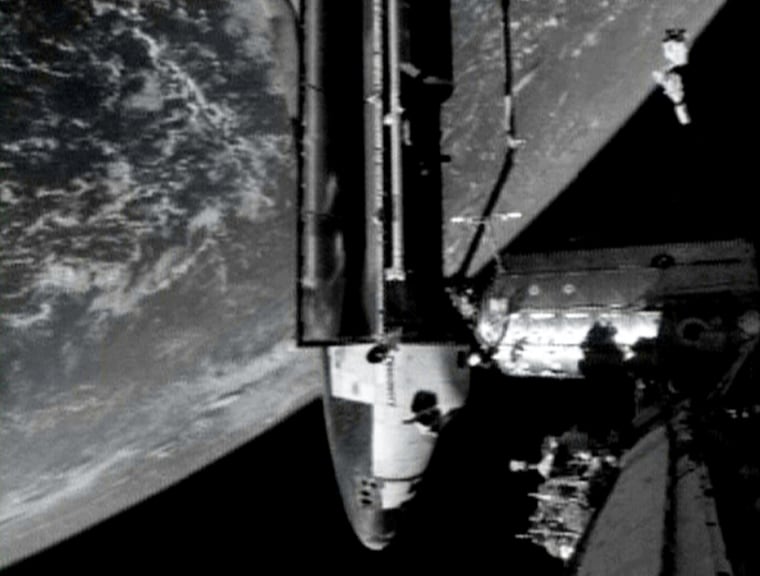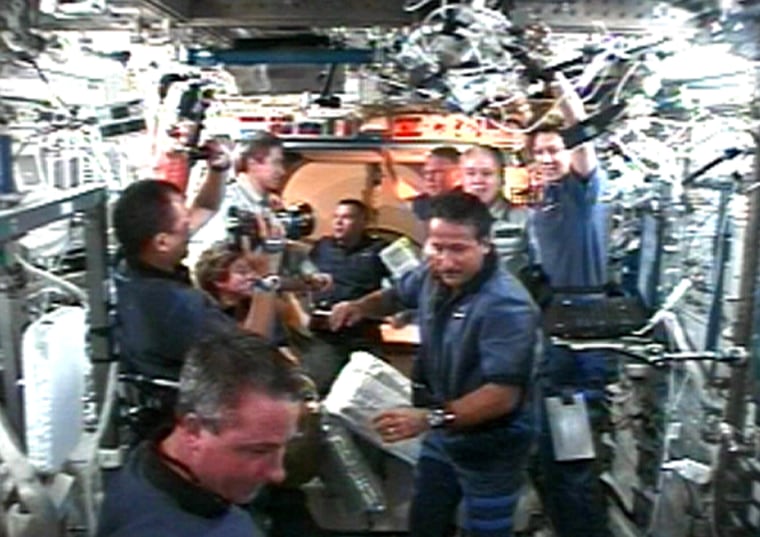Space shuttle Discovery escaped damage from the potentially deadly chunk of foam that broke off from the fuel tank during liftoff, but may have been struck in the wing by a much smaller piece, NASA said Thursday.
Even if the small foam fragment did hit, engineers believe the impact caused no damage of concern, said deputy shuttle program manager Wayne Hale.
“This is the closest to a potential hit that we have out of all the data we’ve got,” Hale said at an evening press conference. That’s why it generated “a great deal of interest,” he added.
Despite the latest development, officials said Discovery still looks safe to fly home in a week, but stressed it will be another few days before the space agency can conclusively give the shuttle a clean bill of health.
The astronauts awoke just before midnight Thursday, ready to continue work to unload 15 tons of cargo onto the space station, do some additional surveys of the shuttle and prepare for the mission’s first spacewalk on Saturday.
The mostly welcome news came after Mission Control received stunningly detailed photographs of Discovery taken by the crew aboard the international space station. The shuttle executed an unprecedented backflip to bare its belly to the cameras before docking with the space station.
NASA wanted to make sure Discovery did not suffer the kind of mortal wound that brought down Columbia in 2003.
“Everything we know at this point in time, I don’t see anything that would keep us from being able to re-enter,” said Steve Poulos, manager of the orbiter project office.
On Wednesday, NASA suspended all further shuttle flights after learning that a big piece of foam insulation weighing just short of a pound came flying off Discovery’s external fuel tank in an alarming repeat of the problem that doomed Columbia. It missed Discovery.
The small bit of foam that may have hit Discovery’s right wing came off about 20 seconds after the big piece, and was from the same general area, Hale said. None of the wing sensors detected anything unusual there, and a laser-tipped inspection boom also did not pick up any damage. Camera views during liftoff were inconclusive because the foam tumbled out of sight.
NASA already has run tests showing that if the foam did strike the wing, it would have exerted just one-tenth of the energy needed to cause worrisome damage, Hale said. “So we feel very good about this,” he said, noting that “we’re going to find the source of these problems and resolve them.”
All that remains before NASA can clear Discovery and its seven astronauts for landing is an inspection Friday by a new laser-tipped boom that will provide 3-D views of scraped thermal tiles on the shuttle’s belly. The 100-foot crane will be able to determine the depth of what looks to be surface-coating damage, said John Shannon, flight operations manager.
One of the areas of biggest interest is a chipped thermal tile near the set of doors for the nose landing gear.
If everything checks out as NASA expects, then Discovery will be free to return to Earth on Aug. 7 as planned, following an eight-day space station visit.
Images from space
Shuttle managers were stunned after seeing video images of the large piece of foam shooting off the fuel tank two minutes after Tuesday’s liftoff. It weighed about half as much as the piece that slammed into Columbia’s left wing and was irregular in shape, at 24 to 33 inches across.
It was not until Wednesday, after viewing more video and still images from space, that managers knew where the foam came from. The foam broke off an area meant to protect cables and pressurization lines running down the length of the 15-story fuel tank, not even close to the location of Columbia’s broken insulation.
Three smaller pieces of foam broke off the same vicinity of Discovery’s fuel tank, including a 7-inch-long chunk that missed Discovery and the fragment that may have went into the wing.
Shuttle managers considered modifying the area after Columbia’s catastrophic re-entry on Feb. 1, 2003. But they put it off because they had had little trouble with the foam there in the past, and it was a relatively easy area to check for air pockets that might cause the insulation to pop off during launch.

Shannon said that decision was based on limited flight data. Engineers had no good tank images from more than 50 of the 113 previous shuttle launches; of the remainder, only one liftoff resulted in foam loss from that area and it was attributed to a previous repair.
“As everybody who’s come up here in the last two days has said, we were wrong and we missed something and we have to go figure out what it was and go fix it,” Shannon said. “Whether that’s just changing techniques or redesign, we don’t know.”
Until the problem is fully understood and resolved, NASA has decreed that no more shuttles will be launched.
The grounding cast a pall over Mission Control and the rest of the space program. Flight director Paul Hill gave his team a pep talk before Discovery started making its final approach to the space station, reminding them, “We have a job to do. We have a crew that is relying on us.”
Still ahead are three spacewalks by Discovery’s astronauts, supply transfers between the two linked spacecraft, the shuttle’s undocking, and its descent back to Earth.
“We don’t have the luxury of sitting around and thinking about what does this mean to the program, or what are we going to do after” Discovery’s mission, Hill said. He added, “It’s all about taking care of Eileen Collins and her crew.”
